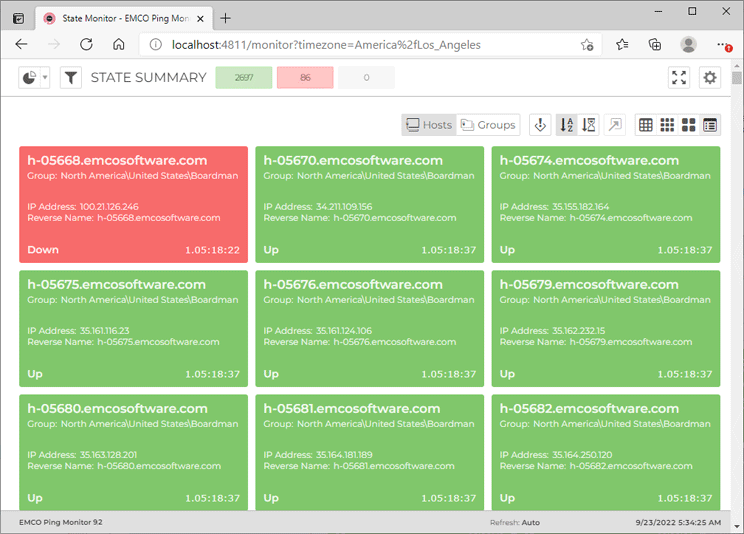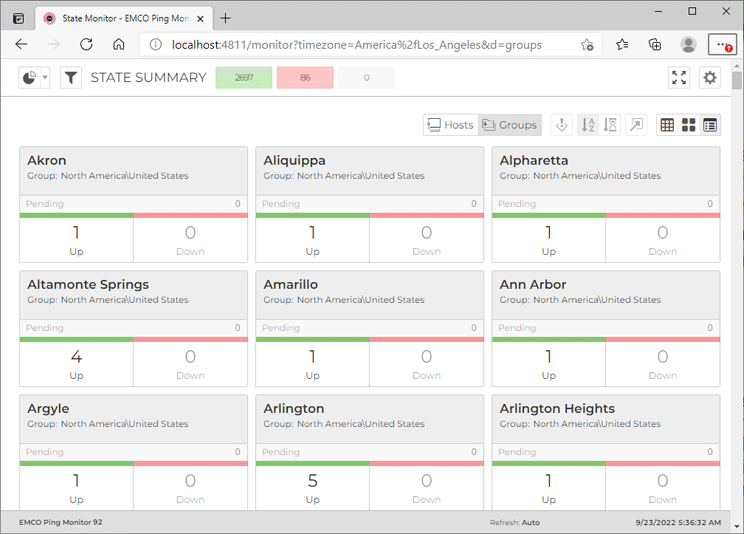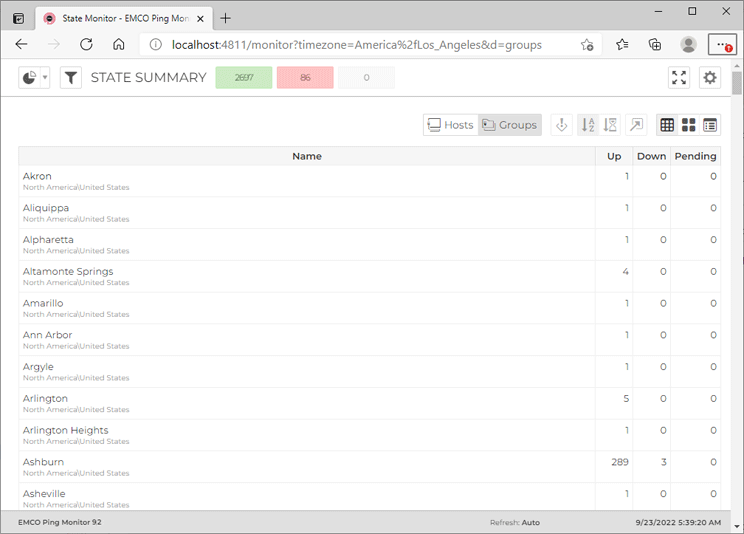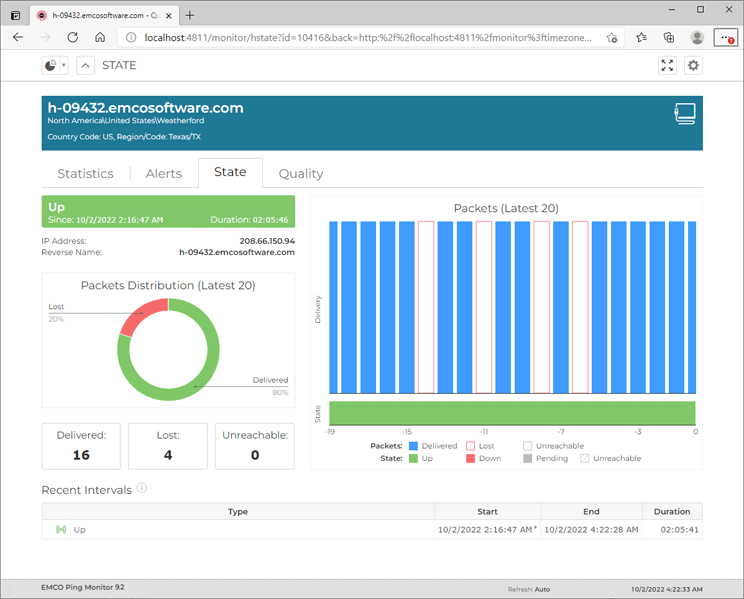State Page
The State page is designed to be used for focusing on hosts states monitoring, where you can easily detect any problematic situations just in time. The page displays only those hosts the monitoring is currently active for. It is possible to monitor per-host states as well as the states distribution for groups of hosts. The default data representation on page is organized with the help of tiles displaying the objects being monitored, that are colored to indicate of the hosts states. Alternatively the hosts state information can be represented as a table. Let us take a closer look at the page. To open the State page you need to select the State Summary item in the main menu.
State Summary
When you click the State Summary item in the main menu, you navigate to the page that displays state information for multiple hosts. By default this page represents hosts as tiles Pic 1. Each tile in the page represents a single host that is currently monitored and is colored with the host state color: green – for up, red – for down, and gray – for pending. In case the host is currently unreachable, thus the state is represented with the latest reachable one, the tile is hatched.
Together with the state, for each host you can find out how long has the host been in this state, the group the host is located in, the host IP address and resolved reverse name. All these information is available in the tool-tip and on the tile itself, when the large tiles are used. For medium tiles, you can see the host name and label on the tile together with the state time stamp. The small tiles are simply filled with the host state color – any information is available in the tool-tip only.
Together with per-host state monitoring, it is possible to monitor state for host groups. The group tile can either represent the group or the set of individual hosts (selected individually or not belonging to any group) Pic 2. The group tile is displaying the number of hosts within the group that are currently in specific states. When monitoring state in grouped mode, you can click on the group to focus on hosts from that group, or click on the specific state part within a group to focus on hosts with that specific state.
You can switch between different modes using the corresponding buttons on the toolbar.
Toolbar Overview
|
Hosts The Hosts button is used to configure the page for monitoring each host individually. |
|
Groups The Groups button is used to configure the page for monitoring groups of hosts. |
|
Group by Severity The Group by Severity button allows you to group the page the way that the problematic nodes are always displayed on top. |
|
Sort by Name When monitoring hosts, the Sort by Name button enables the page sorting by entry name. |
|
Sort by Time When monitoring hosts, the Sort by Time button enables the page sorting by state change time stamp. |
|
Focus on Problems The Focus on Problems button allows you to configure the page to be automatically scrolled to entries that go down, when grouped by severity and sorted by time. |
|
Table The Table button switches the page to the table data representation. |
|
Small The Small button switches the page to the mode where each monitored host is represented just with a pictogram describing its state. Any other information on the entry is available in the tool tip only. |
|
Medium The Medium button is used to switch to the mode where each entry is represented with a tile containing only the summary information on the entry. The detailed info is available in the tool tip. |
|
Large The Large button enables the mode where a tile representing each entry contains maximum information on the entry being monitored. |
All entries within the State Summary page can be grouped by severity so that the problematic entries are always on top. To enable such grouping, use the Group by Severity button on the toolbar. For example, when enabled, the hosts, that are down, will be displayed on top, then hosts that are up will follow the down ones, then there will be the hosts with the pending state. To switch between tiles of different size, use the Small, Medium and Large buttons.
You can configure the State Summary page to show information only for specific hosts and/or groups using the filter editor that is reached using the Filter button next to the navigation menu in the left top corner of the page. Using the filter editor, you can also filter the page to display hosts with specific states. The refresh interval is configured within the Advanced Options drop-down button from the right top corner.
The State Summary page can display host state information as a table. To activate table representation you need to click the Table button on the toolbar. In the table mode each host is displayed as a row, you can see host name, state and other information as columns.
Host State
You can also focus on monitoring specific hosts. To monitor single host, just click the tile the host is represented with. As the result you drill-down to the host level. The page containing the monitoring details for this host will be displayed Pic 4.
On the detailed state monitor page, in the left top corner you can find the block that is quite similar to the large tile representing the host and contains the same information. Below this block, you can view the information on the distribution for the twenty latest packets. To the right those latest packets are displayed in the chronological order as well as the host state that is reached after each response.
On the bottom of the detailed sate monitor page you can find the area with recent state intervals (state changes). It displays all states the host had during the last hour.













